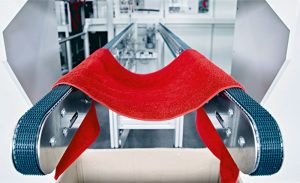
PC-based automation enables rapid development and configuration of manufacturing systems for terrycloth towels.
By Stefan Ziegler
Texpa Maschinenbau GmbH & Co. KG in Saal an der Saale, Germany, specializes in transfer sewing lines for home textiles as well as in plaiting machines. To best adapt these machines to the customer’s requirements, the mid-sized company emphasized modularity as much as possible in its wide-ranging systems, which produce home textiles like bedsheets, pillowcases, drapes and towels.
“Our broad process expertise, consistent equipment modularity and in-house production depth down to highly complex components like sewing tools enable us to deliver machines with extremely short lead times,” said Heiko Hillenbrand, manager of electronics engineering at Texpa. “The time from order receipt to delivery can be as short as three months.”
All machines designed by the company feature maximum flexibility with regard to product sizes and quick product changeovers. Texpa’s new manufacturing system for terrycloth towels exemplifies the importance of the open, flexible and compact PC-based technologies from Germany-based Beckhoff Automation for these applications.
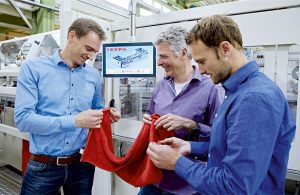
PC-based Control Enables Flexible System Configuration
The new transfer sewing line for terrycloth towels offers even more streamlined setup changeover capabilities and increases the user’s ability to select from various straightening systems with the push of a button. Customers configure their machines from a modular toolbox based on individual requirements regarding the seam size or a suitable label dispenser, for example. In this context, PC-based control and the EtherCAT industrial Ethernet system are extremely important, according to Hillenbrand.
“The PC- and EtherCAT-based control and drive technology from Beckhoff has given us the ability to accommodate a wide range of customer requirements on short notice,” he explained. “It’s the only technology that gives us the necessary flexibility. With conventional programmable logic controller (PLC) hardware and the corresponding program modules, this would have been impossible to achieve in a financially feasible manner. With TwinCAT software, on the other hand, all we need to do is enable the respective module in the control program.”
The transfer sewing line, which is roughly 40 feet (12 meters) long and 23 feet (7 meters) wide, can produce towels ranging from 12 by 12 inches to sauna towels as large as 6 by 6 feet from large reels of continuous fabric material. The machine uses operator input via a visualization system to adjust itself automatically. The maximum output rate for the smallest size is 1,800 towels per hour.
At the start of the process, the continuous terrycloth fabric is fed into a straightening and cutting station. This equipment ensures the fabric is inserted straight, which is particularly important with terrycloth in order to guarantee a flawless hem. Next, the material is cut to size and transferred to a conveyor. After this, up to four tagging stations sew on up to eight different tags, strings or hangers. At the subsequent hemming station, the towels are hemmed and transferred to the “thread hacker.”
“The thread hacker cuts the warp threads,” Hillenbrand explained. “This is where we deployed for the first time eXtreme Fast Control (XFC) technology and the distributed clocks in EtherCAT in order to compensate for the latency times that occur when switching the pneumatic valves on the two cutting wheels. In this way, we can achieve much more precision, i.e. the necessary thread length, at all transport speeds.”
Christian Rott, CTO of Texpa, adds: “The entire system uses 17 XFC EtherCAT I/O terminals, specifically the EL1252 and EL2262. We benefit especially from the EtherCAT timestamp functionality, with which the signal curves can be coordinated across the system via the distributed clocks function.”
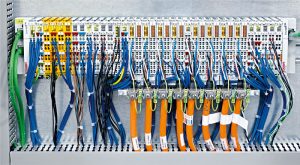
A Powerful And Open Control Platform
The main reason Texpa switched to PC-based control in 2005 was the engineering team’s desire to use a single control hardware for all machine tasks after their previous hardware PLC had been discontinued. Integrating functions such as human-machine interface (HMI) and machine control, for example, in a single device eliminated the need for a separate PLC. The resulting cost advantages were immense, according to Hillenbrand. In addition, the EtherCAT-based communication structure eliminated the need for costly fieldbus masters and simplified data transmission considerably.
Starting in 2007, the company also transferred the motion functions, which were previously integrated in the drive controllers, to the system’s control software by means of TwinCAT NC PTP. “Using TwinCAT NC PTP and centralizing the automation technology has shortened commissioning times significantly,” Hillenbrand said. “If you add the capabilities of the modern modular program structure, the total optimization factor was between twofold and threefold.”
The limited performance of the hardware PLC was another aspect, according to Hillenbrand. “We increasingly reached the limits of the old system, which led to more decentralization,” he said. “At the end, we had to install five or more controllers in one machine, which required a huge communication effort. With its outstanding performance, PC-based control allowed us to make system control more centralized and much more efficient.”
Hillenbrand also values the openness of PC-based control, especially the easy integration of IO-Link into EtherCAT networks. “We often use IO-Link to collect the previously analog sensor signals digitally, which requires much less wiring than before. The numerous valve clusters and the overall system modularity are other areas that benefit from PC-based control. We deploy the EL6224 IO-Link master terminal from Beckhoff, which can be easily parameterized via the EtherCAT master,” he adds.
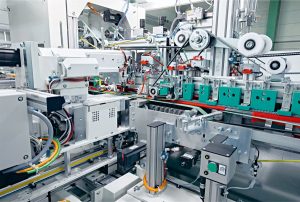
Ultra-Compact Controller And One-Cable Technology Shrink Footprint
Due to the high complexity and extensive modularity of the manufacturing systems, Texpa always pays special attention to the required electrical cabinet footprint. Fortunately, PC-based control from Beckhoff offers many opportunities to minimize this space. Hillenbrand points to the new C6030 ultra-compact Industrial PC as an example: “The C6030 delivers great computing power in an extremely compact format. It takes up much less space than the C6640 and C6650 cabinet IPCs we previously used. Another advantage is the fact that it can fit into existing spaces with great flexibility, for example in extremely flat cabinets. Despite its small size, it still features sufficient interfaces for applications such as providing end users with operating data in connection with Industrie 4.0 concepts.”
With up to 53 NC axes in a single manufacturing system, the drive technology must be equally compact. With One-Cable Technology (OCT), Beckhoff drives require less wiring, produce fewer chances for error and take up less space because of their smaller power supply chains. Texpa deploys them in smaller processing stations and for the tag handling. “We use both EL7041 stepper motor terminals and EL7221 servomotor terminals, the latter in combination with AM8100 OCT servomotors,” Hillenbrand says. “This drive technology in terminal block format reduces space requirements further, minimizes power losses and supports the decentralization of drive technology via easy placement of switching cabinets.”
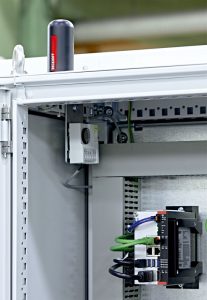
Wireless Connectivity And Protected Power Supply
Texpa keeps benefiting from the continuous expansion of the Beckhoff product portfolio in other aspects of its transfer sewing lines as well. The latest example is the CU8210-M001 cabinet dome for industrial Wi-Fi and mobile communication components such as the CU8210-D00x USB 2.0 sticks. With the cabinet dome, which complies with the IP66 standard, a USB port for wireless connections can be fed out of the control cabinet while still being securely protected.
“We always want to be able to maintain our systems remotely. Normally, we do this over the customer’s intranet, but this means that we must depend on their network administration,” Hillenbrand explained. “When time is of the essence — for example, when a machine has shut down — access might not be possible if the network configuration has changed. With the new cabinet dome and a machine USB stick, on the other hand, we can always access the system without having to go through the customer’s intranet.”
Texpa will also use the new CU81xx series of uninterruptible power supplies (UPS) in the future, according to Hillenbrand: “We prefer the capacitive CU8110 UPS because it does not require maintenance. What’s especially interesting in this context is the UPS-OCT one-cable solution, which employs a 24V DC cable for both the power supply and the communication, which makes the wiring much easier.”
Editor’s Note: Stefan Ziegler is in marketing communications with Germany-based Beckhoff Automation
June 25, 2020




